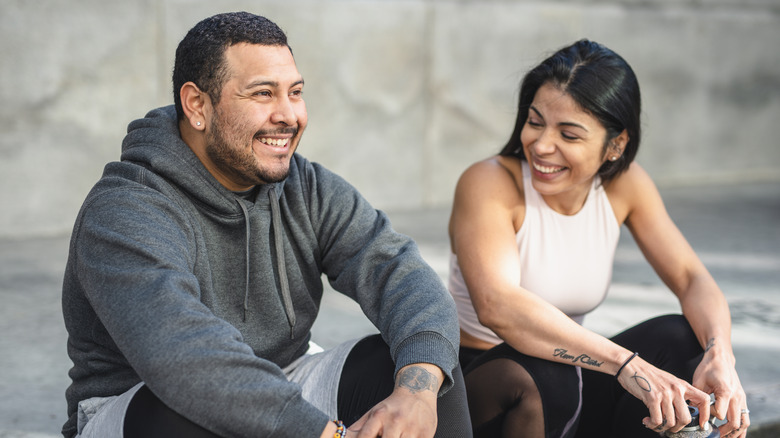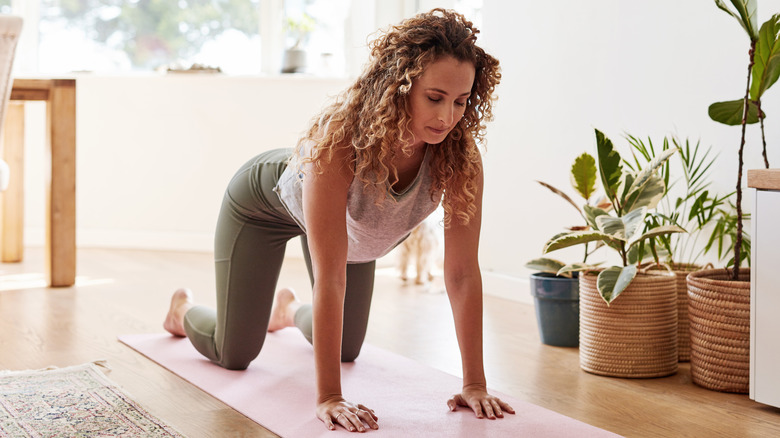The Simple Challenge Women Can Do But Men Can't, According To Our Doctor
TikTok is great at pitting men against women, typically in a fun and harmless way. For instance, there's the #chairchallenge, which saw men and women trying to pick up a chair while resting their heads against a wall. Spoiler alert: the women aced it.
And now, there's the center of gravity challenge. It almost looks like an exercise to improve your balance. If you were to scroll through the videos posted under the hashtag #centerofgravitychallenge, you would see women asking the men in their lives to get down on all fours, side by side, bring their palms to their faces, rest their elbows on the ground, and move their hands in one swift motion behind their backs. While the women in the videos seem to always stay balanced and able to hold their bodies up, the men face-plant straight to the floor. The videos usually end with the men looking surprised that they couldn't do what their female partners just did and the women laughing at the fact that their partners fell clumsily to the ground. Why can women do it and men can't?
In an interview with Health Digest, board-certified orthopedic spine surgeon Dr. Hooman Melamed said that exercises of this nature highlight the physiological differences between men and women. Referring to a similar center of gravity challenge posted by fitness YouTuber Amy's Beach Fitness, Dr. Melamed shared, "The video underscores the inherent physiological differences between men and women. Notably, men tend to have a greater upper body mass compared to women."
Women have a different center of gravity than men
A simple observation of the way a woman's body looks when compared to a man's would tell you that women tend to carry more weight around the hips and lower body. As Mallika Parekh, owner of Physique 57 India and co-founder and CEO of Fluent Health, told Vice, "Due to the generally more curvaceous structure of a woman's hips in proportion to the rest of their body as well as their average heights, the average location of a person's weight tends to be lower in a woman's body, as opposed to men who have more even weight distribution." According to Parekh, that's why women are "more prepared" to perform the challenge than men.
This physiological difference affects where the center of gravity lies for a woman as opposed to a man, explained Dr. Melamed. In simple terms, the center of gravity refers to the average location of the body's weight. For men, it's located higher in their bodies; for women, it's lower. "Consequently, in the specific exercise showcased in the video, it becomes apparent that men face more substantial challenges in supporting their trunks due to the excessive loads involved," said Dr. Melamed.
Findings from a 2010 study published in Theoretical Biology and Medical Modeling seems to confirm this. Per the researchers, women have an "8-15% lower longitudinal center of gravity" than their male counterparts. In addition, it's possible that this anatomical difference happened over time to help women carry children through pregnancy.
The challenge might not just be entirely about center of gravity
Rajiv Ranganathan, an associate professor at Michigan State University's Department of Kinesiology, told Shape that looking at the challenge from the side could provide more insight into whether the center of gravity is the only factor at play during the challenge. Each participant's foot positioning and weight distribution are important, too.
"It seems that the people who maintain balance in this task are leaning back with their weight on their heels when they put their elbows on the floor. This would tend to keep the center of gravity relatively close to the knees and therefore will be easier to balance even when you remove your elbows," shared Ranganathan. Additionally, not all men and women are built the same. Some men have more curves; meanwhile, some women possess narrower hips or a broader upper body. All of these can influence who face-plants and who remains standing, so to speak.
Ultimately, challenges like these can provide an interesting insight into how our bodies are proportioned and structured. Feel like trying the center of gravity challenge? It might be simpler than the viral handstand challenge (although we can't speak for everyone, of course). At the very least, it can give you a better idea of where your center of gravity is actually located. Just be careful when you attempt to do it; perhaps try it while on a mat to minimize your risk of injury (or an embarrassing face-plant).


